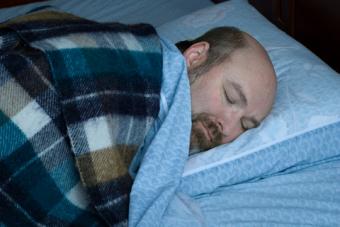
Periodic limb movement disorder (PLMD) is a condition that appears exclusively during sleep. Episodes of jerking and jolting movements in the legs follow a rhythmic pattern and occur in intervals lasting 20 to 40 seconds. PLMD is a problem that disrupts sleep and it may lead to fatigue during the day.
Periodic Limb Movement Disorder
PLMD was first identified in the 1950s as a muscular condition that involved seizure-like spasms. Initially, the disorder was called nocturnal myoclonus but the designation has changed in light of better understanding of the movement problem.
Myoclonus
The National Institute of Neurological Disorders and Stroke describes myoclonus as an erratic twitching or jerking of the muscles that occur with or without a pattern. The jolts of movements are caused by sudden muscle contractions.
PLMD should not be confused with sleep myoclonus, which is a sudden jolting episode that occurs just as the individual is drifting off to sleep. This condition is typically not troublesome and it is not a sleep disorder.
Restless Leg Syndrome
PLMD is not to be confused with restless leg syndrome (RLS). The major distinction is that periodic limb movement is a sleep disorder that wakes the individual while restless leg syndrome occurs while the individual is awake. Those who have RLS have a compelling drive to move their limbs in order to relieve odd sensations. People who have restless leg syndrome have a greater chance of having the limb movement condition, with 80 percent of RLS patients having PLMD. However, many people have the limb disorder without having restless leg problems.
Symptoms of PLMD
A glaring problem experienced by individuals with the limb movement condition is sleep deprivation and daytime fatigue. Many are unaware that they are moving throughout the night until someone else alerts them of the problem. Movements involve arms, appendages and legs.
- Movements last two seconds
- Movements range from wild thrashes and kicks to slight motions
- Movements follow a repetitive pattern, occurring every 20 to 40 seconds
- Movements typically involve joints
-
- Knee
- Ankle
- Big toe
Causes
The causes of the limb condition vary. There are two types of PLMD, primary and secondary. There are no known causes for the primary form of the limb disorder; however, theory suggests that there may be abnormalities in the nerves connecting the brain to the limbs.The secondary form may have a number of different causes including:- Iron deficiencies
- Anemia
- Tumor or trauma in the spinal cord
- Diabetes mellitus
- Sleep apnea
- Narcolepsy
- Kidney problems leading to uremia
- Medications
-
- Tricyclic antidepressants
- Antidopaminergic agents
- Dopaminergic agents
- Withdrawal from sedatives
Treatments
There is no known cure for PLMD but some interventions can significantly reduce the symptoms. Medication therapy is a common approach and many of the medicines used to treat restless leg syndrome are also used to treat PLMD:- Anticonvulsants like gabapentin can reduce the number of muscle contractions that some people experience.
- Benzoddiazepines stifle contractions in the muscles and they can help the patient sleep in spite of movements. Clonazepan is a popular medication used to treat this condition.
- Dopaminergics increase dopamine levels in the brain. Dopamine helps regulate muscle movements. Medications like levodopa work well on some patients but they are not effective for everyone.
- GABA agonists relax contractions by inhibiting specific neurotransmitters that stimulate muscles. Baclofen is a popular GABA medication used in the treatment of the limb movement condition.
Medical Imperative
It is important to seek guidance from a physician if you think that you have periodic limb movement disorder. This is especially significant considering that the secondary form of PLMD has underlying causes that require medical attention.
Conditions that have similar symptoms include seizures and these states may require neurological interventions. Your physician may suggest that you see a neurologist to rule out other possible medical problems.
A polysomnogram, or sleep study may be required in order to receive a reliable diagnosis of the sleep disorder. The study is conducted at a sleep lab and typically requires an overnight stay in order to follow your natural sleep patterns.







